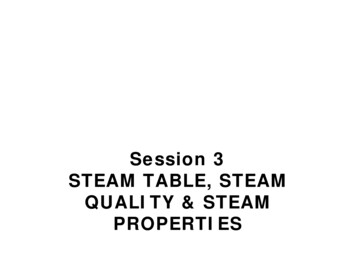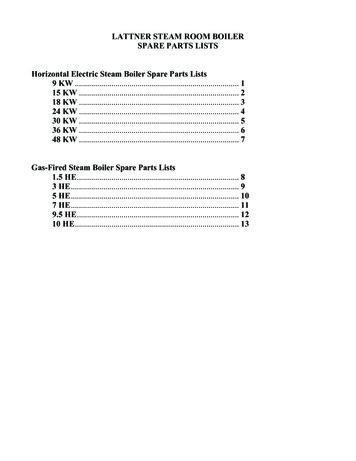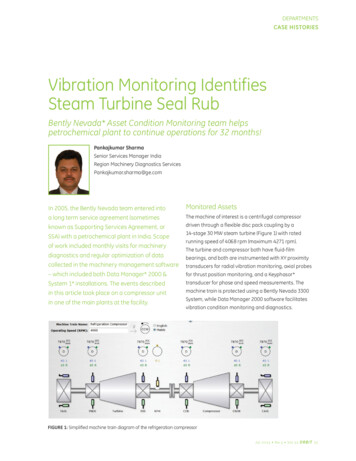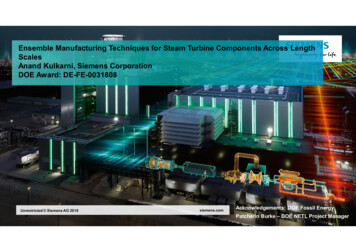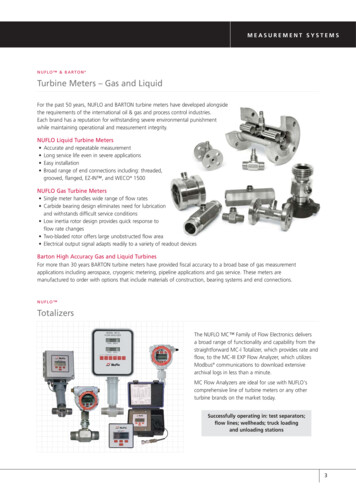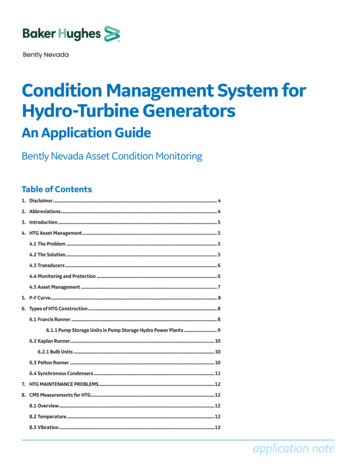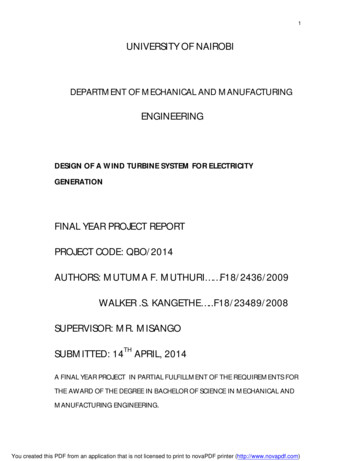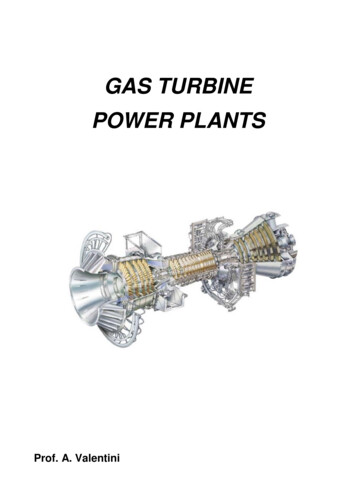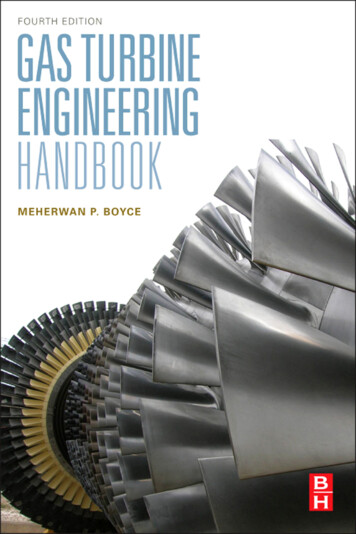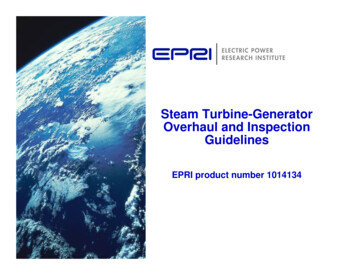
Transcription
Steam Turbine-GeneratorOverhaul and InspectionGuidelinesEPRI product number 1014134
Overview Comprehensive guidelines addressingsteam turbine-generator inspections andmaintenance overhauls Critical industry review of all content,from written specifications to supportingsoftware Annual updates reflecting industryoperating experience, new technologyand R&D advances Guidelines applicable at nuclear andfossil power plants worldwideCopyright Electric Power Research Institute 20082
Unique Elements Portable graphics– All charts, graphics, tables can beextracted for use in plant-specificprocedures, manuals, reports, etc. Templates– Sample outage report– 17 condition assessment data sheets– 155 component-specific data sheets– RFQs (requests for quote) forequipment procurement Foreign material exclusion (FME) guidance Training support– Reference material for in-plant trainingand education of new personnel– Modular approachCopyright Electric Power Research Institute 20083
Guideline Contents Seven volume, four CD setVolume Volume 1 contains generalguidance on planning andconducting turbine-generatormaintenance overhauls andinspections Volumes 2-7 containunderlying technical guidanceand tools supportingmaintenance and overhaulsCopyright Electric Power Research Institute 20081General Practices2Repair Procedures3Balancing and Alignment4Component ProcurementSpecifications5Engineering Database forLarge Steam Turbines6/74ContentBlade/Disk Design Audit andInspection Procedures
What’s New?2007 Updates Generator/exciter grinding procedure(Vol. 2) Turbine blade tuning criteria (Vol. 4) Excitation system purchasespecification, with sample purchaseRFQ (Vol. 4)Planned 2008 Updates Generator hydrogen seal bestpractices (Vol. 2) Turbine bolting purchase specification,with sample purchase RFQ (Vol. 4) Turbine grit blasting procedure (Vol.2) Updated commutator/collector ringprocedure (Vol. 2) Turbine-generator alignment bestpractices (Vol. 3)Copyright Electric Power Research Institute 20085
Where to Find ItQuestionVolumeHow do I determine which vendor is best for my needs?1What should I do to assess my unit before an outage?1What should I do to assess my unit during an outage?1How do I establish an effective outage plan and schedule?1How do I repair a collector ring or turbine diaphragm?2What precautions should I take in selecting and monitoring avendor’s repair work?2What documentation should I request from a vendor for a specificrepair activity?2Copyright Electric Power Research Institute 20086
Where to Find It (continued)QuestionVolumeWhat are the advantages of high-speed vs. low-speed balancing?3How can misalignment affect unit operation?3What shim pad adjustments are needed to re-align my turbine rotor?3What could be causing vibration levels to exceed designspecifications?3What information should I require from vendors in bid documents?4What types of penalty clauses should I include when purchasing newequipment?4What quality control checks should I require of vendors for newequipment?4Copyright Electric Power Research Institute 20087
Where to Find It (continued)QuestionVolumeAre there power plants near me that might have spare parts for myturbine-generator?5What plants have experience with the turbine modifications I’mplanning for my next outage?5How can I assess how much turbine blade run time I have left basedon differing blade failure mechanisms?6/7Which regions of the turbine blading are most susceptible to stresscorrosion cracking?6/7Copyright Electric Power Research Institute 20088
Volume 1General Practices Overview Technical guidance for both on-line andoff-line turbine-generator conditionassessments Pre-outage planning and bidding guidance– Task-oriented information addressingscaffolding, crane availability, lay-downarea, safety, machine disassembly,special tools, etc. Unit shutdown best practices– Identify methods to reduce timerequired to bring unit from full speed toturning gear operation Oil flushing best practices– Techniques to reduce critical path time,such as flushing with minimal externalpiping and filtration Pre start-up checks and post-outageactivitiesCopyright Electric Power Research Institute 20089
Sample Content, Vol. 1In-Service Condition Assessment Enables plant to monitor steam turbine-generator conditionsince last overhaul Addresses 17 systems/components Identifies risk-related recommendations for future outagework (color-coded)– Green: No perceived problems. System or component isexpected to perform reliably until the next assessment.– Blue: No specific immediate or intermediate action necessary,but the issue is significant enough to be monitored.– Yellow: Work required at next convenient outage to avoidpotential forced shutdown if not corrected.– Red: A specific component or system needs immediateattention. High risk of failure, causing loss of unit for anextended time.Copyright Electric Power Research Institute 200810
Sample Content, Vol. 1System/Component Data SheetsSeriesSystem or ComponentData Assembled and Reviewed1Maintenance History SummaryRecord of modifications and upgrades2Turbine-Generator VibrationReadings at minimum-maximum load, criticals3Bearing Metal and Oil TemperaturesReadings at minimum-maximum load4Section Performance ParametersReadings at full load, valves wide open5Start-Up OperationRecord of starts, trips, service hours6Steam PurityFrequency of tests, criteria, out-of-spec events7Lubricating Oil and EHC AnalysisParticle counts, presence of contaminates8Pump Start TestsFrequency of tests, pressures, out-of-spec events9Valve Tightness TestsFrequency of tests, criteria, sticking events10Turbine Trips and TestsRecord of trips, results, consequences11Turbine Monitoring InstrumentationReadings at minimum-maximum load, calibrations12Generator-Exciter ConditionReadings, criteria, test results13Auxiliary System OperationReadings, criteria, test results14Visual Inspection ResultsHP, IP, LP inlets and exhausts15Checklist of Out-of-Limit EventsRecord of unit upsets, actions, and consequences16Current Maintenance PlanRecord of inspections: last, next, frequency17Overall Condition AssessmentSummary with recommended actionsCopyright Electric Power Research Institute 200811
Sample Content, Vol. 1Overall Condition Assessment SheetCONDITION ASSESSMENT SUMMARYDegradationComponent HPXPerformance down 1% - monitorIPXPerformance down 1.5% - monitorXLPXGeneratorXExciterLube oil systemExciter needs balancing. Insulation is very low on bearing.XParticle count far exceeds specifications.XSeal oil systemVacuum values trending toward higher end of acceptable criteria.XControlsOverspeed trip too high. CV crack and intercept points needadjustment.XEHC/MHC systemValvesEnd windings may be loose. Vibration data has not been consistent.Chloride count trending toward higher end of acceptable ppm.XTSIInstrumentationControl valves and main stop valves are sticky. Last inspected threeyears ago.XRecommendations: Both the lubricating oil and valves require attention. Refer to data sheet #5 and #7 for details. Based on their condition, the unitneeds a weekend shutdown as soon as possible. Work is also required on the exciter and turbine controls. Refer to data sheets #12 and #13 fordetails. The urgency is not immediate, but this will require action before the currently scheduled intervals listed for these systems. Refer to sheet #16.Copyright Electric Power Research Institute 200812
Sample Content, Vol. 2Repair Procedures Equally useful for on-site and off-site repairs Scope of Work– Defines tasks to be performed by utility or vendor References/Test Requirements– Defines prerequisites for the repair, such as materials needed,testing techniques, instructions for repair vendor Procedures– Provides numbered steps, supported by checklists andgraphics as necessary Administrative/Report Requirements– Defines reports to be completed post-repair– Includes data sheet templates to be completed by vendorCopyright Electric Power Research Institute 200813
Sample Content, Vol. 2Example: Diaphragm Partition RepairsScope of Work (not comprehensive)– Provide transportation to vendor repair facility.– Remove all diaphragm hardware, place in a bag of sufficientstrength, and tag the bag with the plant name, unit number,and diaphragm stage.– Grit blast diaphragm using 220-grit aluminum oxide orequivalent.– Perform an incoming inspection as outlined in Table 2-2.– Perform a 100% diaphragm partition repair using 410 weldmaterial, assuming a 5/8" cutback is required.– Stress relieve the diaphragm as outlined in Table 2-4.– Perform a final nondestructive evaluation/quality control, andrecord the diaphragm pitch, throat, and radial height data inTable 2-6.– Perform a final outgoing inspection as outlined in Table 2-2.Copyright Electric Power Research Institute 200814
Sample Content, Vol. 2Example: Diaphragm Partition RepairsReferences/Test Requirements (not comprehensive)– Air gap on contour convex side: 0.005" using a contourgauge.– Exhaust edge thickness: 0.040" 0.005" for the first stage high-pressure diaphragm. 0.035" 0.005" for the first intermediate-pressurediaphragm. 0.025" 0.005" for all other diaphragms.– Radial height: Within 0.005"/in. with 0.060" maximumdeviation from end to end.– Edge straightness: Within 0.010"/in. with maximum 0.030" in12" and 0.060" total as checked by a feeler gauge under astraight edge.– Pitch: (3.1416) x radius/number of partitions per halfCopyright Electric Power Research Institute 200815
Sample Content, Vol. 2Example: Diaphragm Partition RepairsProcedure (not comprehensive)1. Lay out diaphragm partition pitches on the inner and outer sidewall faces using atrammel, centerhead, dividers, and center punch.2. Make a copper backing strip to match the diaphragm partition contour, based ondrawing information or data from reverse engineering.20. Take final area check measurements. Set the throats at the X, Y, and Z positions /-0.005" to satisfy area requirements. If throat requirements are not met, thepartition should be cut out and re-welded with 410 filler wire.21. Perform final inspection of diaphragm partitions with an inspection light from theadmission side to reveal any minor grinding and blending corrections that may benecessary where the repair weld joins the original sidewall and partition contours.Copyright Electric Power Research Institute 200816
Sample Content, Vol. 2Example: Diaphragm Partition RepairsAdministrative and ReportRequirements– Repair vendor to providedata package, with allcompleted tables, to thedriver– Vendor instructs driver tohand carry data package todesignated plantrepresentative.Copyright Electric Power Research Institute 200817
Sample Content, Vol. 2Example: Generator RewindScope of Work (not comprehensive)– Technical guidance for the rewind of a General Electricmanufactured, water-cooled generator stator with Micapalinsulation.– Rewind procedures assume that all new bars will be installed.– Includes checklists for pre-outage work, outage work scopeand demobilization.References/Test Requirements (not comprehensive)– IEEE, ANSI, NEMA, OSHA, UL standards– Unit wiring diagrams and stator winding drawings– Latest revision of GE technical information letter (TIL-1098),Inspection of Generators with Water Cooled Stator WindingsCopyright Electric Power Research Institute 200818
Sample Content, Vol. 2Example: Generator RewindDisassembly Procedure (not comprehensive)1.Maintain equipment clearances or have rewind personnel indicate any clearancediscrepancies as needed to support the work scope.2. Prepare bushing box for rewind. Depending on the machine configuration, thephase connections may need to be stripped in this area.3. Release the stator for work. Implement suitable foreign material exclusioncontrols.4. Take measurements on the end winding/turn areas. Make a gauging template toassist with fitting of the replacement bars.5. Sample for asbestos-contaminated material (ACM), and then remove thewedges, top ripple springs, filler, and any side ripple springs.6. Remove the end nose rings.7. Strip back and unsolder the phase connections.8. Saw cut the series loops and ties. Keep loose material and dust fromaccumulating in the machine.9. Cut the Teflon hoses and unbraze the connections to the distribution headers.10. Remove the top and bottom bars along with any filler or old conformingmaterial.Copyright Electric Power Research Institute 200819
Sample Content, Vol. 2Example: Generator RewindAdministrative and ReportRequirements (notcomprehensive) Reports– Clearly address commercialterms in vendor proposals. Materials and equipment– List of required materials– List of expendable items– List of required tools andequipmentNormally required rewind materials (partial list) Safety-related information– Lighting and ventilation– Worker qualifications– Personal protective equipmentCopyright Electric Power Research Institute 200820Item No.Description1Adhesive, epoxy2Bars, bottom – phased3Bars, bottom – standard4Bars, top – phased5Bars, top – standard6Bar seal7Blocks “A”8Blocks “B”9Blocks, conforming space10Blocks, series loop11Bolts, T12Bond, Barco
Sample Content, Vol. 3Balancing and Alignment Procedures, test requirements and reportrequirements for slow-speed and high-speedbalancing of turbine, generator and exciter rotors Primers– Vibration: fundamentals, causes, measurementand instrumentation– Alignment: disassembly data, tight wire alignment,set points, clearance and alignment checks Includes TGAlign software for turbine-generatoralignment– Installation instructions– Users manualCopyright Electric Power Research Institute 200821
Sample Content, Vol. 3TGAlign Software Determines optimum couplingalignment for a turbine-generatorrotor system Input–––––Number/diameter of couplingsRim/face alignment measurementsAlignment and move limitsDistance between bearingsShim pad location for each bearing Output– Bearing position changes foroptimum alignment– Specific shim padadjustments to achievebearing position Benefits––––Reduces potential for calculation errorsMinimizes number of bearings to be movedMinimizes potential for turbine rubs and startup vibrationIncludes manual mode to permit bearing-by-bearing analysisCopyright Electric Power Research Institute 200822
Sample Content, Vol. 4Component ProcurementSpecifications Outlines information needed to assessa vendor quote beyond price and schedule Enables fair comparison of competingproposals Defines criteria to ensure final product is deliveredand installed to agreed design and performancespecifications Ensures the latest technological improvements areincorporated into design Provides sufficient information to non-OEM vendorsto develop competitive bidsCopyright Electric Power Research Institute 200823
Sample Content, Vol. 4Low-Pressure Rotor Procurement RFQ Sample template for bid package or RFQ Form and checklists to be returned with bid– Pricing information– Warranties and penalties– General acceptance criteria– Technical criteria associated with the forging, rotating parts,and stationary parts– Transport of the parts– Post-delivery activities of inspection, alignment, balancing,and testing performanceCopyright Electric Power Research Institute 200824
Sample Content, Vol. 4Low-Pressure Rotor Procurement RFQ Warranties and Penalties (example content)– In the event that the supplier does not provide thedocumentation indicated in this specification, the supplier shallpay X,XXX for each document not supplied.– In the event that the unit does not meet the supplier’sguarantee of increased output in kW, the liquidated damagepenalty associated with the plant’s not achieving this loadincrease at rated reactor conditions shall result in a paymentof XXXXX per kW for each kW not attained.Copyright Electric Power Research Institute 200825
Sample Content, Vol. 4Low-Pressure Rotor Procurement RFQ General Acceptance Criteria (example content)– The rotors shall be warranted for a 30 calendar-year lifebased on the unit’s being operated in accordance with thesupplier’s recommendations.– The rotating and stationary blades shall be warranted for [fiveyears, 40,000 hours, or 1000 start-stop cycles] life (whichevercomes first), assuming that the unit is operated in accordancewith the recommended instructions.– The replacement low-pressure rotors shall result in anincrease of net generation (improvement in generator output)of [1% or 5,000 kWe].Copyright Electric Power Research Institute 200826
Sample Content, Vol. 4Low-Pressure Rotor Procurement RFQ Technical Criteria (examplecontent)– The L-0 and L-1 stages shouldbe designed so that the unitcan operate up to 10" Hg backpressure without flutter(vibration due to aero-elasticinstability of the blades).– If free-standing blades areused, the L-0 and L-1 shouldbe designed to operate underthe same back-pressurecriteria, but these bladesshould also be mix-tuned toreduce the potential for flutterat speed and under load.Copyright Electric Power Research Institute 2008PartAcceptable MaterialBladesAISI 630 (17-4PH), AISI 410,AISI 403, Jethete M-152CoversAISI 630 (17-4PH), AISI 410,AISI 403PinsAISI H11, ASTM A193GRB16Tie wiresAISI 630 (17-4PH), AISI 316Cross-keysType M252 Austenitic Steel RodNotch/bucketTi-6Al-4V or Equivalent27
Sample Content, Vol. 5Steam Turbine Database Global database of large steam turbines– Location, operational data, nameplate rating,manufacturer, status More than 3,000 global entries for units larger than 70 MW Units operating with last-stage blades greater than 23 inches Units mapped to turbine vendors: GE, Westinghouse, ABB,Siemens, GEC, MAN, MHI User value– Identifies plants with like steam turbine units– Helps locate spare parts at plants with same turbine model– Captures experience with turbine modifications at other plantsCopyright Electric Power Research Institute 200828
Sample Content, Vol. 6/7Blade Design Audit andInspection Helps engineers diagnose blade damage during shutdown Permits future run-time estimations based on currentcondition and failure probability– Failure mechanisms: low-cycle fatigue, high-cycle fatigue,stress corrosion cracking, solid particle erosion– Library of failure probability curves for each mechanism Supports maintenance process– Planning and pre-bidding: provide input to generic bladeprocurement specification– Turbine inspection: indicate regions susceptible to fatigue,creep, cracking– Condition assessment: assess crack initiation from resonantvibration; produce interference diagram to compare againstnatural frequenciesCopyright Electric Power Research Institute 200829
Sample Content, Vol. 6/7Blade Designs Addressed HP/IP blade designs and unit configurations–––––GE G3D Unit with a 33.5-inch last-stage bladeGE D3 Unit with a 26-inch last-stage bladeWestinghouse BB44 first-stage reheat bladeGE G3 Unit with a 30-inch last-stage bladeGE G2 Unit with a 33.5-inch last-stage blade LP blade designs–––––––Westinghouse 31-inch L-0 bladeGE 33.5-inch L-0 bladeGE 20.9-inch L-1 bladeGE 43-inch L-0 bladeWestinghouse 23-inch L-0 bladeGE 26-inch L-0 bladeGE 17.4-inch L-1 bladeCopyright Electric Power Research Institute 200830
Together Shaping the Future of ElectricityCopyright Electric Power Research Institute 200831
software Annual updates reflecting industry operating experience, new technology and R&D advances Guidelines applicable at nuclear and . – RFQs (requests for quote) for equipment procurement For
